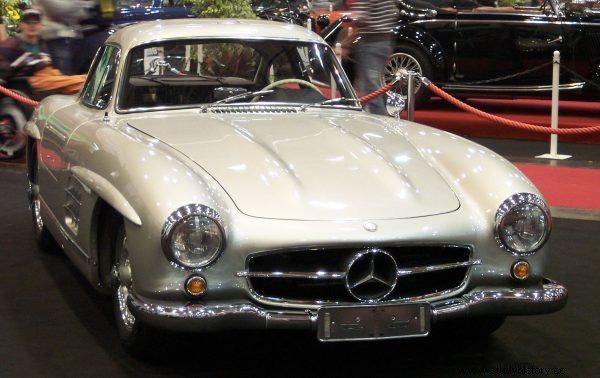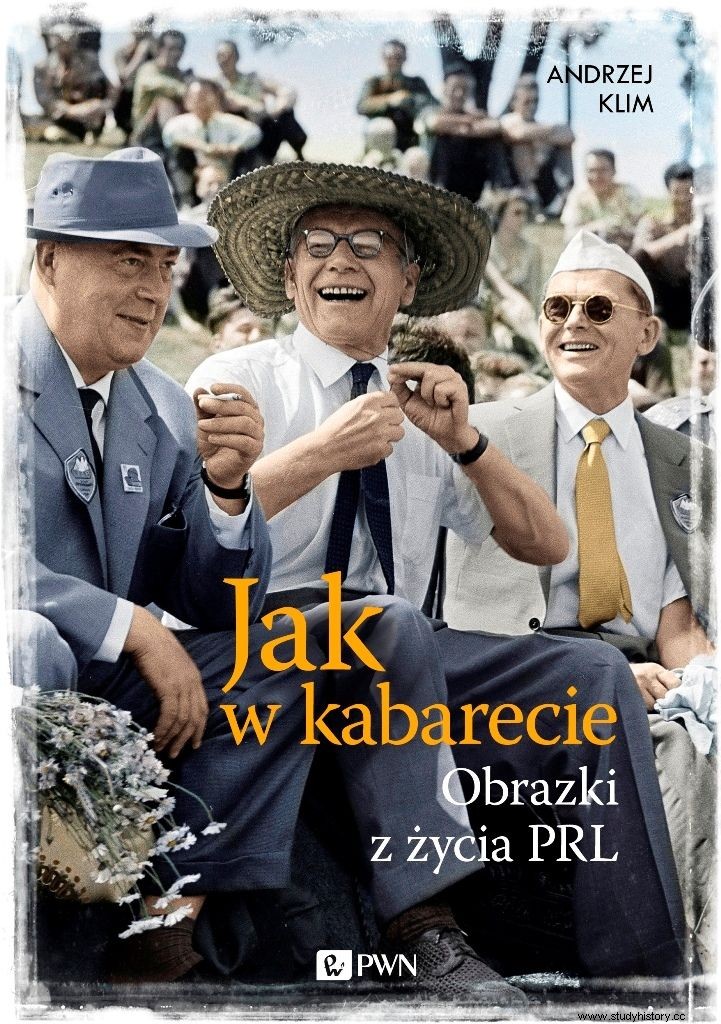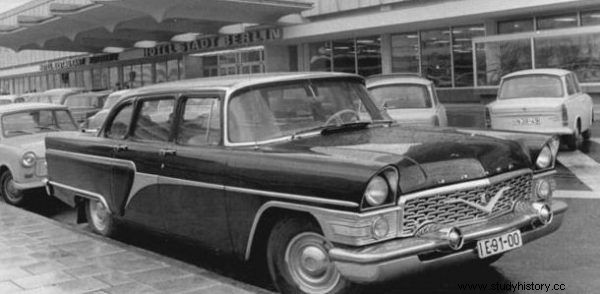The aversion to bourgeois luxuries ended where self-love began. The car as a status symbol - which man can resist the temptation? Lenin himself did not resist, and Polish communists followed his example. Especially since the state money was open ...
The English royal family took a liking to the representative Rolls Royce and Bentleys. US presidents most often used Cadillacs. When Franz Ferdinand Habsburg was shot in Sarajevo, he was driving in an elegant Graf &Stiff car.
Even the leader of the Soviet workers and peasants revolution, Vladimir Lenin, drove a Rolls-Royce . Emphasizing the prestige of an exclusive car is a common practice of power, regardless of the ideological tinge. Also in rough People's Poland.
Slowly and timidly at first (1945-1956)
In the first years after the end of the war, the then dignitaries mostly drove post-German captured cars . These were vehicles from the highest pre-war shelf. Bolesław Bierut, the then president of Poland, had at his disposal two Mercedes 770s, two Maybachs, including one Zeppelin model, and a dozen or so lower-class cars.

In the first post-war years, the young people's government in Poland was driving captured cars. Among them there were also Mercedes 770s, which were liked by, for example, Adolf Hitler (source:Bundesarchiv, license:CC-BY-SA 3.0).
The Supreme Commander of the Polish Army and the Minister of National Defense Marshal Michał Rola-Żymierski drove, among others, a 1938 Cadillac . He probably also had two Soviet exclusive ZIS 101 cars and a few other cars at his disposal. He also occasionally used 770 government Mercedes.
Around 1947, government fleets began to slowly replace captured cars with new American cars. Buicks were brought for the highest officials (including the president), and Chevrolets for the lower-ranking officials . Several copies of Cadillacs, Fords and Studebakers were also purchased.
In the years 1948 - 1952 the Czechoslovak company Skoda produced about one hundred copies of the Skoda VOS car. It was a limousine, powered by a five-liter engine with a capacity of 120 HP, intended exclusively for the highest-ranking dignitaries of socialist countries. Probably seven to nine such cars were imported to Poland, two of which were armored. These were used to transport Comrade Bierut.
The others were to confuse any bombers. Quoted in the book by Andrzej Klim entitled 'Like in cabaret. Pictures from the life of the PRL "Leopold Tyrmand wrote about them as a real terror of Warsaw chauffeurs: do not obey the traffic rules, and even a slight rub against them turns a normal car into rubbish.

Skoda VOS unarmored (author:Ralf Roletschek, license:CC BY-SA 3.0).
At the turn of the 1940s and 1950s, the exclusive Soviet ZIS 110 cars began to appear in Poland. It was then a ideologically perfect car - prestigious, conveniently and manufactured in the Soviet Union . It was available to the most important dignitaries. President Bierut was driving one of these cars. Interestingly, his bodyguards (several cars) drove Chevrolets.
The dignitaries are starting to take off (1956 - 1970)
In March 1956, Bierut died mysteriously, and after the June and October events, a new team led by Władysław Gomułka came to power.
He was the enemy of any luxury - would prefer to eat only potatoes and black pudding, and for business he would drive a ladder cart. Nevertheless, the position of his office forced him to move in appropriate cars.

The column of ZIS 110 cars on the day of signing the agreement on the Polish-German border in Zgorzelec (source:Bundesarchiv, license:CC BY-SA 3.0).
On the other hand, the second after God - that is Prime Minister Józef Cyrankiewicz - was a great lover of cars. As Andrzej Klim writes in his book: he liked Western brands, of course; he liked to drive a Mercedes and Citroën . Of course, he financed his passion from the state budget.
The advent of the new rulers coincided with a fairly serious depletion of government vehicles purchased a few years earlier. So it was decided to purchase new vehicles. In the second half of the 1950s, about twenty exclusive Mercedes 300 "Adenauer" cars were imported for the needs of the government .
This article has more than one page. Please select another one below to continue reading.Attention! You are not on the first page of the article. If you want to read from the beginning click here.
There were also three four-door convertible cars, which were intended for the private use of party dignitaries . Aleksander Zawadzki rode one of them, including the long-term chairman of the State Council. Interestingly, one of these cars was found a few years ago and is now in a private collection in Luxembourg.

Mercedes 300 "Adenauer". Party dignitaries drove such cars among others (author:Ra Boe, license:CC BY-SA 3.0).
In the 1950s and 1960s, it was customary for the Office of the Council of Ministers to buy all the cars exhibited at the fair after the exposition of the Poznań International Fair was completed. This way, each year the dignitaries received a few very exclusive cars and a dozen or so middle-class cars. Some remained in ministerial fleets, others were sold to high-ranking officials.
For example, in 1957, a sports Mercedes 300 SL was exhibited at the fair. After the end of the event, it was purchased by the Office of the Council of Ministers and handed over to Prime Minister Cyrankiewicz. Cyrankiewicz also had a sports Jaguar E-type , probably also from the fair . His wife - Nina Andrycz - also drove a Jaguar, only the X model.
For official state visits and national celebrations - reported by the press and shown on television and in Film Chronicles - both representative and "politically correct" cars were needed, therefore from the beginning of the 1960s people started buying a few from time to time , Soviet cars GAZ-13 Czajka.

Prime Minister Cyrankiewicz loved foreign cars. One of his acquisitions was a Mercedes 300 SL (author:Ashley Pomeroy, license:CC BY-SA 3.0).
The highest generals of the Polish Army liked Chevrolets, Soviet GAZ-12 ZIM cars and Mercedes cars. The lower-ranking officers had to be content with the Soviet Volga. In 1964, during the parade commemorating the 20th anniversary of the People's Republic of Poland, the highest commanders of the Polish Army received the parade standing in two Soviet ZIL-111 convertible cars.
The press was forbidden to write about the luxury cars of state and party dignitaries and television forbid filming them. Officially, everything was supposed to be crude, ascetic and politically correct. Gossiping about it was also effectively punished.
Full speed ahead! (1971 - 1981)
The bloody suppressed workers' protests on the coast in December 1970 compromised the "workers" authorities of Poland. Gomułka and Cyrankiewicz and people closely related to them were removed from power. Edward Gierek became the new ruler of Poland.

The article was based, among others, on the book by Andrzej Klim entitled “Jak w kabaretcie. Pictures from the life of the People's Republic of Poland ”(Polish Scientific Publishers PWN 2016).
Unlike his predecessors, he promoted the policy of "opening to the west", "socialism with a human face", "friendly cooperation between government and society" and many pro-social reforms. It was thanks to his efforts that the production of "a car for Kowalski", i.e. the Polish Fiat 126p, was started in Poland. which, as Andrzej Klim emphasizes in his book, was then one of the symbols of Gierek's consumerism .
Political loosening and approval of the consumerist lifestyle were quickly used by the state offices. Literally a few months after the advent of Gierek's teams, they started introducing Western cars into their fleets among which Mercedes were the most popular. This was clearly shown in the cult comedy "I don't like Monday", where it was swarming with official Mercedes cars - ministerials and industry unions.

Although the people's government represented the working-class and peasant masses, somehow none of its representatives switched to the "little one". The photo comes from the book "Jak w kabaretcie" (source:NAC).
In his biography, Edward Gierek stayed in France for several years, hence Peugeots started to appear in the government fleet. But the Soviet representative GAZ-13 Chaika limousines were still used for official visits.
Cars "in case of W"
People's Poland was a politically unstable country. There were social uprisings and even armed riots . Evacuation cars were also prepared for this occasion. At the end of the 1970s, the armored Cadillac Fleetwood arrived in Poland. This is one of the most interesting stories about government cars.
In the second half of the 1970s, the value of this vehicle with professional armor was around $ 100,000 . At that time, the average monthly salary in Poland was around $ 30, at the black market rate. It was therefore the equivalent of 3,300 such salaries that is 275 years of work of one average Pole. In foreign exchange sales, the Polish Fiat 125p cost around $ 1,800 at the time.

The armored version of this car was supposed to leave the capital by Edward Gierek, should there be social unrest (source:public domain).
Jerzy Dziewulski, who at the turn of the 1970s and 1980s was the head of the anti-terrorist units at the Warsaw district of Okęcie, tells how at the end of the 1970s his unit was asked if they would like to have a Western car at their disposal. - In those days of permanent automotive hunger, such a question was even rhetorical - of course we wanted to - says .
The vehicle made a great impression. - We proceeded to the opening [container] and… we stopped dead. Inside was a brand new Cadillac Fleetwood, a top-of-the-line model! We couldn't catch our breath for a long moment - Dziewulski reports. But that wasn't the only surprise:
After shaking off the first impression, came another wave of surprise. The car had American license plates and was armored to an unprecedented degree . It was an extremely professionally armored car. The panes were about 6-7 cm thick. The doors were so thick and heavy that they had special actuators to open them. There were special shot-proof tires on the wheels.
This Cadillac was probably the first car, after the aforementioned Bierutów VOS skoda, so professionally armored and prepared especially for the Polish government. Protected against firearms bullets, grenades and all kinds of mines , and the make-up for the American embassy car (with American license plates) was to protect against the anger of the people.
Thoroughly and thoughtfully hidden in a container in the center of Warsaw, it was waiting for its use. Who knows if in other parts of Warsaw, for the same purpose, there were also other equally interesting cars hidden?
Inhibition (1982 - 1989)
After the suppression of "Solidarity" and the imposition of martial law, the then military authorities used cars of the government fleet, purchased back in the 1970s.

The Soviet car Gaz-13 Czajka was used for many years of the People's Republic of Poland to support official events (source:Bundesarchiv, license:CC BY-SA 3.0 de).
General Wojciech Jaruzelski had a rather pragmatic approach to company cars. They were supposed to be safe, functional and inconspicuous. At that time, the government fleet included:Mercedes, Peugeot, Volvo. Soviet Lapwings were still used to handle official events of the highest rank.
In the 1980s, several (7 - 9 pieces) passenger SUVs of the Korean brand Ssangyong were brought to the army. The assumptions were that these cars were to be used for comparative tests in military research institutions. In practice, however, they became available vehicles for the generals of the People's Army of Poland.
Bibliography:
- "Auto Moto Sport" from 1957 - 1958.
- Andrzej Klimkąm, Like in a cabaret. Pictures from the life of the People's Republic of Poland , Polish Scientific Publishers PWN 2016.
- "Motor" from 1955 - 1975.
- "Automotive" from 1947 - 1950.
- Polish Film Chronicle from 1945 - 1990.
- The testimony of Jerzy Dziewulski to the author on June 10, 2010
- Interviews with Andrzej Esse conducted in 2007 - 2012.
- Interviews with Władysław Paszkowski conducted in 2005 - 2010.
